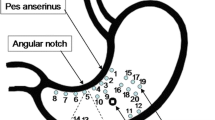Abstract
The aim of this study was to determine whether food ingestion causes a change in the susceptibility of the stomach to dysrhythmia or in the characteristics of gastric dysrhythmia. The susceptibility of the stomach to develop dysrhythmia was measured by determining the median effective dose of four different drugs known to produce gastric dysrhythmia. These drugs were epinephrine, PGE2, met-enkephalin, and glucagon. The median effective dose for inducing gastric dysrhythmia was measured in four healthy conscious dogs by Dixon's up-and-down method during fasting and after feeding. The median effective dose of epinephrine, PGE2, met-enkephalin, and glucagon were higher after feeding (16.6, 16.6, 35.1,>221 μg/kg, respectively) than during fasting (1.7, 5.2, 11.1, 61.0 μg/kg, respectively). The results indicate that feeding renders the stomach less susceptible to pharmacologically induced dysrhythmia. However, characteristics of gastric dysrhythmias, such as site of origin and direction of propagation, were similar whether they occurred during fasting or after feeding.
Similar content being viewed by others
References
Reynolds RPE, Bardakjian BL, Diamant NE: A case of antral tachygastria: Symptomatic and myoelectric improvement with gastroenterostomy and domperidone therapy. Can Med Assoc J 128:826–829, 1983
You CH, Lee KY, Chey WY, Menguy R: Electrogastrographic study of patients with unexplained nausea, bloating and vomiting. Gastroenterology 79:311–314, 1980
Geldof H, van der Schee EJ, van Blankenstein M, Grashuis JL: Gastric dysrhythmias; an electrogastrographic study. Gastroenterology 84:1163, 1983 (abstract)
Abell TL, Camilleri M, Malagelada J-R: High prevalence of gastric electrical dysrhythmias in diabetic gastroparesis. Gastroenterology 88:1299, 1985 (abstract)
Sanders K, Menguy R, Chey W, You C, Lee K, Morgan K, Kreulen D, Schmalz P, Muir T, Szurszewski J: One explanation for human antral tachygastria. Gastroenterology 76:1234, 1979 (abstract)
Telander RL, Morgan KG, Kruelen DL, Schmalz PF, Kelly KA, Szurszewski JH: Human gastric atony with tachygastria and gastric retention. Gastroenterology 75:497–501, 1978
Kim CH, Azpiroz F, Malagelada J-R: Characteristics of spontaneous and drug-induced gastric dysrhythmia in a chronic canine model. Gastroenterology 90:421–427, 1986
Code CF, Marlett JA: Canine tachygastria. Mayo Clin Proc 49:325–332, 1974
Gullickson GW, Okuda H, Shimizu M, Bass, P: Electrical arrhythmias in gastric antrum of the dog. Am J Physiol 239:G59-G68, 1980
Ormsbee HS III, Mason GR, Bass P: Effects of pyloroplasty on the electrical activity of the canine gastroduodenal junction.In Proceedings of the Fifth International Symposium on Gastrointestinal Motility. G Vantrappen (ed). Herentals, Belgium, Typoff, 1975, pp 293–299
Daniel EE: The electrical and contractile activity of the pyloric region in dogs and the effects of drugs. Gastroenterology 49:403–418, 1965
Dixon WJ: Quantal-response variable experimentation: The up-and-down method.In Statistics in Endocrinology. JW McArthur, T Colton (eds). Cambridge, Massachusetts, MIT Press, 1970, pp 751–767.
Abell T, Malagelada J-R: Glucagon-evoked gastric dysrhythmias shown by an improved electrogastrographic technique. Gastroenterology 88:1932–1940, 1985
Stoddard CJ, Smallwood RH, Duthie HL: Electrical arrhythmias in the human stomach. Gut 22:705–712, 1981
You CH, Chey WY: Study of electromechanical activity of the stomach in humans and in dogs with particular attention to tachygastria. Gastroenterology 86:1460–1468, 1984
Go VLW, Miller LJ: The role of gastrointestinal hormones in the control of postprandial and interdigestive gastrointestinal function. Scand J Gastroenterol 18(suppl 83):135–142, 1983
Hinder RA, Kelly KA: Canine gastric emptying of solids and liquids. Am J Physiol 233:E335-E340, 1977
Schang JC, Kelly KA, Go VLW: Postprandial hormonal inhibition of canine interdigestive gastric motility. Am J Physiol 240:G221-G224, 1981
Miolan JP, Roman C: Discharge of vagal efferent fibers supplying gastric antrum: Indirect study using nerve suture technique. Am J Physiol 235:E366-E373, 1978
Rees WDW, Malagelada J-R, Miller LJ, Go VLW: Human interdigestive and postprandial gastrointestinal motor and gastrointestinal hormone patterns. Dig Dis Sci 27:321–329, 1982
Sarna SK, Daniel EE: Threshold curves and refractoriness properties of gastric relaxation oscillators. Am J Physiol 226:749–755, 1974
Sanders KM, Bauer AJ, Publiconer NG: Regulation of gastric slow wave frequency by prostaglandins.In Gastrointestinal Motility. C Roman (ed). Lancaster, England, MTP Press, 1984, pp 77–85.
Author information
Authors and Affiliations
Additional information
This study was supported in part by grants AM 26428 and AM 07198 from the National Institutes of Health.
Rights and permissions
About this article
Cite this article
Kim, C.H., Malagelada, JR., Azpiroz, F. et al. Meal reduces sensitivity of the stomach to pharmacologically induced dysrhythmia. Digest Dis Sci 32, 1027–1032 (1987). https://doi.org/10.1007/BF01297194
Received:
Revised:
Accepted:
Issue Date:
DOI: https://doi.org/10.1007/BF01297194




